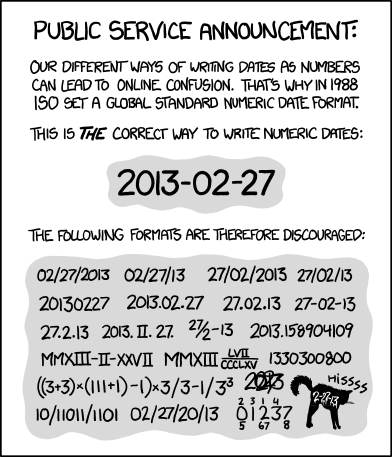Dates
Only the information on this page defines the ISO8601 standard for Arctos.
- Date and time values are organized from the most to the least significant: year, month, day, hour, minute, second, timezone. The lexicographical order of the representation thus corresponds to chronological order.
- Each date and time value has a fixed number of digits that must be padded with leading zeros.
- Representations can be done in only one format, often referred to as the extended format with separators added to enhance readability. The separator used between date values (year, month, and day) is the hyphen, while the colon is used as the separator between time values (hours, minutes, and seconds). For example, the 6th day of the 1st month of the year 2009 may be written as “2009-01-06.”
- For reduced accuracy, any number of values may be dropped from any of the date and time representations, but in the order from the least to the most significant. For example, “2004-05” is a valid ISO 8601 date, which indicates the 5th month of the year 2004. This date will never represent the 5th day of some unknown month in 2004.
Supported components
- 4-digit positive year. Example: 1987 (optionally followed by dash and…)
- 2-digit month of the year. Example: 1987-04 (optionally followed by dash and…)
- 2-digit day of the month. Example: 1987-04-28 (optionally followed by the character T and…)
- 2-digit hour of the day (days have 24 hours). Example: 1987-04-28T13 (optionally followed by colon and…)
- 2-digit minute of the hour. Example: 1987-04-28T13:34 (optionally followed by colon and…)
- 2-digit second of the minute. Example: 1987-04-28T13:34:17 (optionally followed by
timezone, given by any one of…)
- The letter Z, designating UTC time zone. Example: 1987-04-28T13:34:17Z
- The character + followed by a 2-digit positive offset from UTC. Example: 1987-04-28T13:34:17+03
- The character – followed by a 2-digit negative offset from UTC. Example: 1987-04-28T13:34:17-11
- 4-digit negative year. Example: -1987. By convention 1 BC is labelled +0000, 2 BC is labeled -0001, and so on.
Usage Notes
Most natural history data are provided with one-day accuracy, and a YYYY-MM-DD date format will work for most things most of the time. Most date fields in the Arctos interfaces include a calendar date picker which will suggest an appropriately-formatted day. (Close the calendar with the ESCAPE key to enter a different format.) Traditional collecting activities might record an identical began and ended date, giving precision to day:
- Began_Date: 2010-08-27
- Ended_Date: 2010-08-27
For scientific sampling activities, a more precise timespan could be recorded. For example, perhaps a mist net is opened for 15 minutes. Specimens collected during that time could be entered as:
- Began_Date: 2010-08-27T09:30
- Ended_Date: 2010-08-27T09:45
This describes an ambiguous 15-minute timespan. The event began on the 27th day of August 2010 at some local time, rounded to the nearest minute, and ended 15 minutes later. A less ambiguous description would be:
- Began_Date: 2010-08-27T09:30:00-07
- Ended_Date: 2010-08-27T09:45:00-07
This describes the same 15-minute timespan with more accuracy (to the second) happening seven hours before UTC (perhaps in California during the summer, which is Pacific Daylight Time or GMT-7). This is precise and unambiguous, but can be difficult to work with. For example, how does it compare to 2010-08-27T09:45:00+04, and how can a user compare those two events? An alternative and preferred method would be to record UTC time. The following example describes a timespan identical to the above example, but is easier to compare to other such data.
- Began_Date: 2010-08-27T16:30:00Z
- Ended_Date: 2010-08-27T16:45:00Z
Note that timezone offset should NOT be used to infer location. GMT-7 could mean the data were recorded in California in the summer, Montana in the winter, or could simply reflect the collector’s equipment settings. Other date data may be recorded with less precision. For example, Agents’ birth and death dates are often known only to year. To record this information, one could simply enter:
- Birth_Date: 1927
Excel Issues
See How To Manage Excel for Arctos - Dates
Caution on using “special” dates
year-only dates Be careful with these, Excel will interpret these as ‘days since 1900-01-01’. So the year 2005 will become 1905-06-27. Make sure the field is formatted to number or text so that Excel won’t intrpet the date for you.
Restricted Data
For some records, the year of collection is withheld by the collection. For these records, the year-component of ISO8601 dates is given as “8888.”
Edit this Documentation
If you see something that needs to be edited in this document, you can create an issue using the link under the search widget at the top left side of this page, or you can edit directly here.

